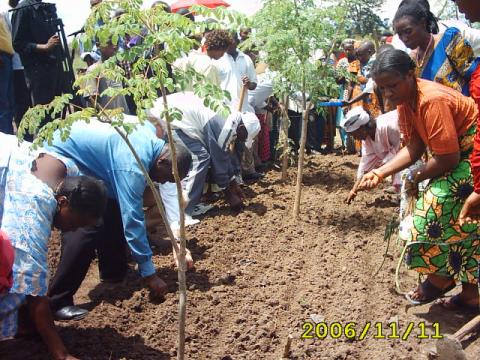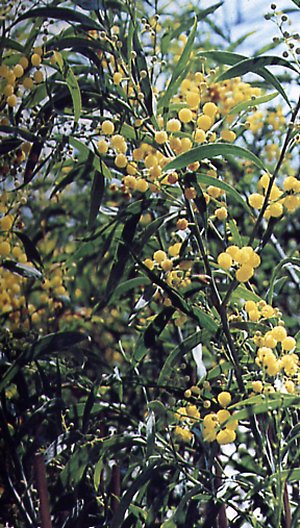Field Guide for Emergency Water Treatment with Moringa oleifera
by Beth Doerr, ECHO Staff, March 2005
echo[at]echonet.org
Introduction
Using natural materials to clarify water is a technique that has been practiced for centuries and of all the materials that have been used, seeds of the Moringa tree have been found to be one of the most effective. Studies have been conducted since the 1970's to test the effectiveness of Moringa seeds for treating water. These studies have confirmed that the seeds are highly effective in removing suspended particles from water with medium to high levels of turbidity (Moringa solutions are less effective at treating water with a low level of turbidity).
Theory
Moringa oleifera seeds treat water on two levels, acting as both a coagulant as well as an antimicrobial agent. It is generally accepted that Moringa works as a coagulant due to positively charged, water-soluble proteins which bind with negatively charged particles (silt, clay, bacteria, toxins, etc) allowing the resulting “flocs” to settle to the bottom or be removed by filtration. The antimicrobial aspects of Moringa continue to be researched. Findings support recombinant proteins both removing microorganisms by coagulation as well as acting directly as growth inhibitors on the microorganisms. While there is ongoing research being conducted on the nature and characteristics of these components, it is accepted that Moringa treatment will remove 90-99.9% of the impurities in water.
Water Treatment
Solutions of Moringa seeds for water treatment may be prepared from either seed kernels or from the solid residue left over after oil extraction (presscake). Moringa seeds, seed kernels or dried presscake can be stored but solutions for treating water should be prepared fresh each time.
To treat 10 liters of water: Remove the outer coating from mature Moringa seeds and crush the white kernels to obtain a fine powder (do not use discolored seeds). Add 5 ml (1 teaspoon) of powder to 250 ml (1 cup) of clean water and shake for 1 minute to activate the coagulant properties. Filter this solution through a clean cloth into the 10 liters of water to be treated. Stir the water rapidly for at least 1 minute, then slowly (15 to 20 rotations per minute) for 5-10 minutes. Let the water sit without disturbing for at least one hour. After the particles and contaminates have settled, the clear water from the top can be used.
 Dosage Rates:
Dosage Rates:
Low turbidity NTU<50 1 seed per 4 liters water
Medium turbidity NTU 50-150 1 seed per 2 liters water
High turbidity NTU 150-250 1 seed per 1 liter water
Extreme turbidity NTU >250 2 seeds per 1 liter water
10 Steps for Household Water Treatment
1. Collect mature Moringa oleifera seed pods and remove seeds from pods.
2. Shell seeds (remove seed coat) to obtain clean seed kernels.
3. Crush seed kernels (using grinder or mortar & pestle) and sift the powder through a screen or small mesh.
4. Mix fine seed powder with clean water to form a paste. In general, one seed kernel will treat one liter of water.
5. Mix the paste and 1 cup of clean water into a bottle and shake for 1 minute to form a solution.
6. Pour this solution through a muslin cloth or fine mesh screen (to remove insoluble materials) into the water to be treated.
7. Stir treated water rapidly for at least 1 minute and slowly for 5-10 minutes.
8. Let the water sit without disturbing for 1-2 hours.
9. When the solid materials have settled to the bottom, the clean water can be carefully poured off.
10. The clean water can then be filtered or sterilized to make it completely safe for drinking.
a. Sand Water filters:
http://www.cawst.org/technology/wate...on-biosand.php
b. Solar Sterilization:
http://www.sodis.ch/
c. Chlorination: 1-2 drops per liter
d. Boiling: 5 minutes minimum
Dangers
Secondary Infection: The process of shaking and stirring must be followed closely to activate the coagulant properties; if the flocculation process takes too long, there is a risk of secondary bacteria growth during flocculation.
Recontamination: The process of settling must be followed closely and the clear water should be poured /filtered off for use. The sediment at the bottom contains the impurities so care must be taken to use only the clear water and not allow the sediment to contaminate the cleared water.
Additional contaminants: Moringa treatment does not remove 100% of water pathogens. It is acceptable for drinking only where people are currently drinking untreated, contaminated water.
Additional Notes
Seeds of the Moringa stenopetala have been found to be more effective than the Moringa oleifera for purifying water.
Some studies have found that the levels of the active components in Moringa seeds were lower in the rainy season suggesting that seeds for water purification should be collected during the dry season.
For water with medium turbidity levels, 2 trees could supply sufficient seeds for water treatment for a family of five.
Relevant Websites
http://www5.gtz.de/gate/techinfo/tec...s/w1e_2000.pdf
http://www.jalmandir.com/
http://www.lboro.ac.uk/well/resource...cal-briefs.htm
http://www.who.int/household_water/en/
http://www.safewaterintl.org/Complete%20Survey.pdf
http://www.le.ac.uk/engineering/staf...ga/moringa.htm
http://www.lwr.kth.se/Publikationer/...R_PHD_1013.pdf
References
Fuglie, Lowell. 2001. The Miracle Tree: pages 47-48.
http://www.moringatrees.org/miracletree.html
Folkard, Geoff, John Sutherland, and Rod Shaw. 1999. “Water Clarification using Moringa oleifera Seed Coagulant”. Waterlines. Vol 17: pages 109-112.
Ghebremichael, Kebreab. 2004. “Moringa Seed and Pumice as Alternative Natural Materials for Drinking Water Treatment”. KA Royal Institute of Technology.
Jahn, Samia. 1984. “Traditional Water Clarification Methods”. Waterlines. Vol 2: pages 27-28.
Schwarz, Dishna. 2000. “Water Clarification using Moringa”. Gate. W1e.













 اقتباس
اقتباس






